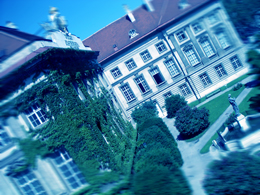
Esther van GELDER, MA wird im Rahmen des Josephim-Seminars einen Vortrag zum Thema „The court garden as medicinal garden – collection of wonders, or
laboratory of nature? Carolus Clusius and the development of botany at Central-European courts (1573-1588)“ halten.
- Ort: Lesesaal des Josephinum, (Währinger Straße 25, A – 1090 Wien)
Zeit: 19. Mai 2008, 17.00 c.t.
Kontakt: sammlungen@meduniwien.ac.at
++43/ 1/ 40160/ 26000
Carolus Clusius (1526-1609) was an important figure in the ‚botanical renaissance‘ of the sixteenth century. In 1573 he was called to the court in Vienna in order to create a ‚hortus medicorum‘ for Emperor Maximilian II. During his stay at the imperial court (1573-1577) Clusius encountered many new plants, which were imported from the Ottoman Empire by imperial ambassadors and he came to know other aristocratic garden owners in the Holy Roman Empire. But unfortunately, it is still unclear what Clusius‘ function precisely entailed and we do not know what kind of garden this was. After the emperor’s death in 1576, Clusius stayed in Vienna and remained in close contact with rich garden owners. He helped with to design their gardens, expand their collections of exotic plants and cultivate new plants. In return, Clusius was able to observe rare plants in these gardens. But surprisingly, the botanist became quite negative about entering the service of another patron again.
My research focuses on the relationship between patronage and the development of botany as a new field of scientific expertise in the life and work of Carolus Clusius. In this presentation I will explore the activities of Clusius in various court gardens in Austria and Germany between 1573 and 1588, with special attention for the imperial court in Vienna. What role did court gardens play in the botanical research of Clusius? Can we see them as impressive collections of natural objects – as a living counterpart of the indoor ‚Kunst- und Wunderkammern‘? And did they also function as laboratories of nature where observations of the life-cycle of plants and experiments with cultivation could take place? Two main themes are connected with these questions:
1) the development of a professional identity as a botanist at the court;
2) the relationship between botany and horticulture in the 16th C.Esther van Gelder studied Arts and Sciences at the University of Maastricht, the Netherlands, where she developed a special interest in the scientific and visual culture of the Early Modern period. After graduating in January 2003 she worked as a research and teaching assistant at the University of Maastricht. In 2004-2005 she attended the Masters Program of Medieval and Renaissance Studies at the Catholic University of Louvain (Belgium). In her MA thesis she analysed the pictorial and literary techniques used in the chapters about natural history of a well known Dutch travel report (Linschoten). In 2005 she entered the Clusius Project as a PhD student (Scaliger Institute, University Library Leiden), to investigate the relationship between botany and patronage in the life and work of the sixteenth century botanist Carolus Clusius. The title is: /Clusius and botany in the context of Habsburg court and aristocratic culture (circa 1570-1590); /supervised by Prof. Dr. M.E.H.N. Mout (Department of History, Leiden University). Esther is especially interested in Clusius‘ use and appreciation of pictures and gardens in his scientific work as well as in his activities for rich patrons. Furthermore, she is the co-founder and coordinator of the Dutch study group „Material Culture of Science“. This study group wants to bring together researchers from various disciplines and museums by organizing workshops and conferences about the use of illustrations, instruments and collections in science until 1800, in close collaboration with Dutch libraries, archives and museums:
http://www.pallas.leidenuniv.nl/index.php3?m=1&c=83#Werkgroep (in Dutch).
